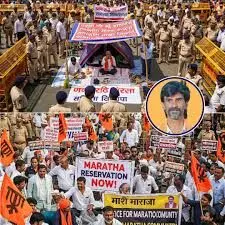- Home
- »
- Breaking News »
- The End of the Mumbai Maratha Protest:...
The End of the Mumbai Maratha Protest: What's New in the Government Resolution?
Explore the Government Resolution (GR) that led to the end of the Maratha reservation protest in Mumbai on September 2, 2025, detailing the key demands accepted, the contentious Kunbi status, and why some community leaders questioned the GR's meaningful change.

Introduction
The prolonged and highly impactful Maratha quota agitation, which culminated in a massive protest at Mumbai's Azad Maidan, officially concluded on September 2, 2025. Led primarily by activist Manoj Jarange Patil, the protest was called off after the Maharashtra state government presented a Government Resolution (GR) to the agitators, agreeing to a number of their core demands. The central issue remained the demand for reservation for the Maratha community by including them under the Other Backward Classes (OBC) category, primarily by recognizing them as Kunbis, an existing OBC caste. While the GR was hailed as a victory by Jarange-Patil, an immediate note of skepticism arose from other community leaders and experts, who questioned its substance, asking the pertinent question: "What is new in the GR?" This article delves into the details of the resolution, the demands that were accepted, and the reasons behind the community's lingering doubts.
Government Resolution and the Kunbi Status
The pivotal demand of the Maratha quota agitation, which led to the winding down of the Mumbai protest, centered on granting Kunbi status to Marathas. The Kunbi community is a sub-caste of Marathas who are already classified under the OBC category, which enjoys reservation benefits. By establishing that Marathas and Kunbis are the same, activists aim to secure reservation benefits under the existing OBC quota, thereby bypassing the legal challenge of exceeding the 50% reservation ceiling which had struck down previous attempts.
Implementation of the Hyderabad Gazette
The most crucial point accepted by the government and formalized in the GR was the immediate implementation of the Hyderabad Gazette.
This document is significant because the Marathwada region—from where the protest leader Manoj Jarange Patil hails and where the movement has strong support—was historically a part of the erstwhile Hyderabad State. The Hyderabad Gazette, dating back to the Nizam-era, reportedly includes entries that recognize many Marathas in the Marathwada region as Kunbis.
The GR announced the formation of a special committee and proposed a process to facilitate the issuance of Kunbi caste certificates to Marathas in the Marathwada region who can provide genealogical and historical evidence of their Kunbi heritage based on the records found through the Hyderabad Gazette.
Unresolved and Pending Demands
While the GR was immediately issued for the Hyderabad Gazette, the government sought more time for other related demands.
The implementation of the Satara Gazette and other regional gazettes (like Pune-Aundh and Bombay) was deferred, with the government citing a need for one to two months to study the legal implications and conduct due diligence before issuing formal GRs.
Another critical demand that was not immediately resolved was the official issuance of a GR declaring Marathas and Kunbis as one and the same community across the state. The cabinet sub-committee informed the agitators that this would require legal scrutiny and a more extensive process, likely taking about two months, due to the voluminous records and administrative complexities involved.
The highly contentious demand for the inclusion of 'Sage Soyare' (blood relatives and marital relations) in the notification for issuing Kunbi certificates also required time. The government acknowledged receiving a massive number of objections (reportedly around 8 lakh) to the draft notification on 'Sage Soyare' and needed time to scrutinize them before proceeding.
Other Accepted Demands
Beyond the core quota demands, the government also agreed to several other points put forth by the activist Manoj Jarange Patil and the protesting groups.
Withdrawal of Cases
The state government agreed to withdraw all remaining police cases registered against Maratha protesters during the agitations of 2023 and 2024. This was a key demand to ensure that the youth who participated in the movement would not face legal repercussions. The government assured that this process would be completed by the end of September 2025.
Compensation and Jobs for Families
The government also committed to providing financial compensation (ex gratia) and offering government jobs on compassionate grounds to the kin of those Maratha youth who lost their lives during the quota protests. It was decided that jobs would be provided according to the educational qualifications of the family members, and the entire process, including the remaining financial assistance, would be completed within a week.
The Source of Doubt: "What is New in the GR?"
Despite the celebrations led by Manoj Jarange Patil upon receiving the GR, senior leaders and experts within the Maratha community expressed deep reservations, prompting the question: "What is new in the GR?"
Lack of Novelty in the Process
The primary criticism leveled by activists like Sanjay Lakhe Patil, Convener of the Maratha Kranti Morcha, and others, was that the new GR's process for granting Kunbi certificates to Marathas in Marathwada was not a novel mechanism. They argued that the government's pre-existing Justice Sandeep Shinde (retd.) committee was already mandated to search for Maratha-Kunbi and Kunbi-Maratha records and issue certificates to eligible individuals. The new GR, critics claim, merely formalizes this existing process, rather than simplifying it or relaxing the core requirement.
The Need for Documentary Proof
Community experts highlighted a major practical flaw: the GR, while implementing the Hyderabad Gazette, still requires individuals to furnish documentary evidence—such as genealogical or revenue records dated prior to November 21, 1961—to prove their Kunbi ancestry.
Sanjay Lakhe Patil noted: "There is nothing in the Gazette that can establish that a person was Kunbi. It only mentions the Kunbi population. If anyone doesn't have records to prove they are Kunbi, they cannot get the certificate... So what is new?"
This means that Marathas who genuinely lack the necessary historical records will not benefit from the new GR, leaving a large segment of the community outside the purview of the OBC quota. Activists like Vinod Patil, who has filed petitions on the quota issue, outright called the GR "completely useless" for those without existing Kunbi lineage proof.
Limited Scope and Legal Vulnerability
The GR's immediate benefit is largely restricted to Marathas in the Marathwada region. The delay in finalizing GRs for other gazettes and for the 'Maratha-Kunbi as one' declaration leaves the remaining Maratha population waiting and skeptical. Furthermore, the decision has already faced legal opposition. OBC groups, such as the OBC Mukti Morcha, have moved the Bombay High Court to challenge the GRs, arguing that they are unconstitutional and create an unfair advantage by blurring the lines between the Maratha and Kunbi communities. This immediate legal challenge highlights the fragility of the GR's purported solution.
Conclusion
The cessation of the Maratha reservation protest in Mumbai on September 2, 2025, marked a temporary political victory for the state government and a celebratory moment for activist Manoj Jarange Patil. The key outcome was the issuance of a Government Resolution (GR) to implement the Hyderabad Gazette, forming a committee to issue Kunbi certificates to eligible Marathas in Marathwada with verifiable genealogical records. However, the community leaders' skepticism—expressed in the query, "What is new in the GR?"—is rooted in the fact that the resolution appears to primarily streamline an existing process and still hinges on the availability of historical documentary proof. The core demand for an all-encompassing, legally viable reservation for the entire Maratha community remains a work in progress, entangled in further administrative delays, pending GRs for other regions, and fresh legal challenges from other backward communities. The end of the street protest is merely the beginning of the legal and administrative battle for meaningful, permanent, and undisputed Maratha reservation.
FAQ's
1. What was the core demand of Manoj Jarange Patil's recent agitation that led to the September 2nd Government Resolution (GR)?
A. The core demand of Manoj Jarange Patil and the Maratha community was to be included under the Other Backward Classes (OBC) category for reservation in government jobs and education. This was primarily sought by issuing Kunbi caste certificates to eligible Marathas, particularly those from the Marathwada region, based on historical records like the Hyderabad Gazette.
2. What was the main promise made by the Maharashtra government in the September 2nd GR to address the Maratha quota issue?
A. The Maharashtra government issued a Government Resolution (GR) on September 2, 2025, which announced the formation of a committee to verify documents and facilitate the issuance of Kunbi caste certificates to members of the Maratha community who can provide historical evidence of their Kunbi heritage, especially based on the Hyderabad Gazetteer. Kunbi is an OBC caste in Maharashtra.
3. What was the deadline set by Manoj Jarange Patil for the government to start the implementation and distribution of Kunbi certificates?
A. Manoj Jarange Patil demanded that the Maharashtra government must begin the distribution of Kunbi caste certificates to Marathas in Marathwada before September 17, 2025 (Marathwada Liberation Day), warning of a "tough decision" if the implementation of the GR was delayed or obstructed.
4. What is the current status of the Kunbi certificate distribution process and its impact?
A. The process is facing significant legal and political challenges despite the GR. While the government agreed to the committee formation, it stated that not all Marathas will get blanket Kunbi certificates—only those with documentary proof. The process of issuing certificates is now intertwined with:
Legal Challenges: Several petitions have been filed in the Bombay High Court by OBC groups challenging the GR, claiming it is unconstitutional, arbitrary, and dilutes the existing OBC quota.
Political Opposition: Prominent OBC leaders, including Minister Chhagan Bhujbal, have openly criticized the GR, alleging it was issued in haste, without Cabinet consultation, and threatens the reservation of genuine OBC communities.
5. What are the key arguments being presented by the Other Backward Classes (OBC) communities against granting Kunbi status to Marathas?
A. The major arguments from OBC groups challenging the move include:
The government's decision is a "backdoor entry" for the Maratha community into the OBC quota.
It will dilute or encroach upon the reservation share of the genuine 374 castes already listed under the OBC category.
They cite past rulings and commissions that have stated Marathas and Kunbis are two different communities.
They allege the GR uses vague wording (like "in relation" instead of "blood relatives") which could be misused to grant certificates broadly without proper documentation.
Explore the Government Resolution (GR) that led to the end of the Maratha reservation protest in Mumbai on September 2, 2025, detailing the key demands accepted, the contentious Kunbi status, and why some community leaders questioned the GR's meaningful change.
Explore the Government Resolution (GR) that led to the end of the Maratha reservation protest in Mumbai on September 2, 2025, detailing the key demands accepted, the contentious Kunbi status, and why some community leaders questioned the GR's meaningful change.


